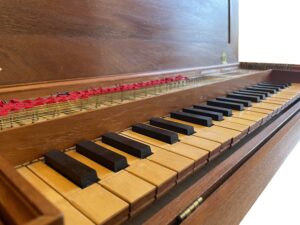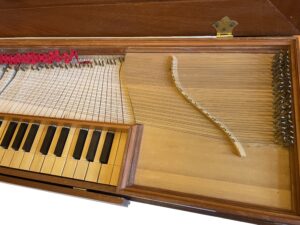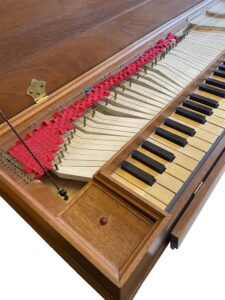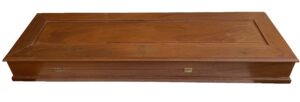Zuckermann after Georg Woytzig (1688) 1990
Description

| Date: | 1990 |
| Origin: | --- |
| Serialnumber: | --- |
The clavichord occupies a special place in the history of keyboard instruments. Between the 15th and 18th centuries, it not only served as a practice instrument for musicians, but was also valued for solo performances. Its outstanding feature is its ability to create nuanced dynamics, which sets it apart from other contemporary keyboard instruments such as the harpsichord.
Although the clavichord was increasingly replaced by the more advanced fortepiano in the late 18th and early 19th centuries, it experienced renewed appreciation in the 20th century through historical performance practice, led by Wanda Landowska (1879 – 1959). In modern musicology, it serves as a key instrument for researching the playing practice and musical expression of the Baroque and early Classical periods. Working with the clavichord not only offers a return to past musical traditions, but also a deeper insight into the sound aesthetics of an era in which the connection between musician and instrument was more direct and personal than ever before.

Clavichord Zuckermann King of Sweden, c. 1990 after Georg Woytzig (1688) – Eric Feller Collection (2)
The clavichord presented here was built from a kit by Zuckermann around 1990, which was designed based on an instrument by Georg Woytzig from 1688. This model is marketed by Zuckermann under the name “King of Sweden” and is very popular with musicians. Due to its compact shape, low weight and charming sound, this instrument offers the possibility of authentically reproducing the literature of the 16th and early 17th centuries.

Clavichord Zuckermann King of Sweden, c. 1990 after Georg Woytzig (1688) – Eric Feller Collection (3)
The instrument does not have a stand. The case is built from American cherry wood and the soundboard consists of spruce. The tangents are made of brass. The range is 45 keys (C/E – c3), the strings are double-chord and made of brass. The clavichord is triple-fretted.

Clavichord Zuckermann King of Sweden, c. 1990 after Georg Woytzig (1688) – Eric Feller Collection (4)
As the only mechanical keyboard instrument, the clavichord has the possibility of influencing the sound even after the tangent has been hitting the string by changing the pressure on the key periodically. This creates the typical vibrato effect that only clavichords can produce.

Clavichord Zuckermann King of Sweden, c. 1990 after Georg Woytzig (1688) – Eric Feller Collection (5)
| Length: | 100 cm |
| Width: | 30 cm |
| Height: | 11,5 cm |
| Circumference: | 4 octaves (C/E – c3) |
| Mechanics: | double-strung, triple-fretted |
| Pedals: | --- |
| Signature: | --- |

